Spatiotemporal Evolution Patterns of “Production-Living-Ecological” Spaces and the Coordination Level and Optimization of the Functions in Jilin Province
Abstract
:1. Introduction
2. Materials and Methods
2.1. Study Area
2.2. Data Sources
2.3. Research Method
2.3.1. Classification System of the Land Use in PLES
2.3.2. Dynamic Degree of Land Use
2.3.3. Evaluation Index System of PLE Functions
- (1)
- Data standardization
- (2)
- Weight determination by the entropy method
- (3)
- Construction of a comprehensive evaluation model
2.3.4. Coupling Coordination Model
2.3.5. Spatial Autocorrelation Analysis
- (1)
- Global Moran’s I Index and Local Moran’s I Index
- (2)
- Hot Spot Analysis
3. Results
3.1. Evolution Characteristics of the PLES Spatial–Temporal Pattern in Jilin Province
3.1.1. Characteristics of the PLES Land Use Dynamic Degree Change
3.1.2. Characteristics of the Spatial Distribution Pattern of PLES
3.1.3. Aggregation Characteristics of the PLES
3.2. Coupling Coordination of the PLE Functions in Jilin Province
3.2.1. Coupling Coordination Result
3.2.2. Hot Spot Analysis Results of the Coupling Coordination Degree
3.3. Division of the PLES Functions and Their Optimization Path in Jilin Province
4. Conclusions and Discussion
- (1)
- The ecological space scale was the largest, followed by the production space, and the living space scale was the smallest in Jilin Province. In the past two decades, the ecological space area gradually decreased from 69.57% in 1998 to 56.29% in 2018, and the living space area increased slightly from 3.95% in 1998 to 4.36% in 2018. The production space area showed little change in the first decade of the study period, increasing from 31.95% in 2008 to 39.39% in 2018.
- (2)
- The spatial distribution pattern of the PLES in Jilin Province showed a remarkable clustering feature, and there were many “high–high” and “low–low” types. The production space was mainly concentrated in the central region, and the proportion of the production space in the western region had been increasing in recent years. The living space was mainly concentrated in the central region of Jilin Province; the ecological space was mainly concentrated in the eastern region and the western region. There was a decreasing trend in the study period.
- (3)
- The PLES functions in each county of Jilin Province were in the coupling coordination level of being slightly and moderately uncoordinated, and the coordination needs to be improved. The coupling coordination degree showed the spatial differentiation characteristics of “high in the east and west, low in the east; high in the plain and low in the mountain”. Through the hot spot analysis, it was found that the hot spots were scattered in 1998, with a single-core reunion in 2008, and scattered in the western and central regions in 2018. The cold spots were all concentrated in the eastern part. Yanji City was taken as the single core in 1998, showing zonal distribution; the cold spots showed a layer structure in 2008, and a decreasing trend in 2018.
- (4)
- Jilin Province was divided into four areas in this paper: the central plains and hills region of productive and living complex functions area, the central–eastern hills region of ecological and productive complex functions area, the eastern mountain region of ecological-dominant and production-limited area, and the western plains region of production-dominant and ecological-conservation area. According to the characteristics and main problems of the different types of areas, this paper put forward the optimization methods to promote the coordinated development of the PLES.
Author Contributions
Funding
Institutional Review Board Statement
Informed Consent Statement
Data Availability Statement
Acknowledgments
Conflicts of Interest
References
- Jiao, G.; Yang, X.; Huang, Z.; Zhang, X.; Lu, L. Evolution characteristics and possible impact factors for the changing pattern and function of “Production-Living-Ecological” space in Wuyuan county. J. Nat. Resour. 2021, 36, 1252–1267. [Google Scholar] [CrossRef]
- Guo, Y.; Zhou, Y.; Liu, Y. Spatial-temporal evolution of rural population outflow and its mechanism in China. Sci. Geogr. Sin. 2020, 40, 50–59. [Google Scholar] [CrossRef]
- Yu, S.; Zhao, M. Research status summary of domestic“three-life space”research based on bibliometrics. J. Guangzhou Univ. (Nat. Sci. Ed.) 2018, 17, 76–82. [Google Scholar]
- Zhang, Y. Urbanization in China and its eco-environmental effects: A review on the discussion of “2018 Chinese Humanities and Social Science Environment Forum”. J. Nanjing Tech Univ. (Soc. Sci. Ed.) 2019, 18, 1–10. [Google Scholar]
- Liu, Y.; Liu, Y. Progress and prospect on the study of rural hollowing in China. Geogr. Res. 2010, 29, 35–42. [Google Scholar]
- Wang, D.; Jiang, D.; Fu, J.; Lin, G.; Zhang, J. Comprehensive assessment of Production–Living–Ecological Space based on the coupling coordination degree model. Sustainability 2020, 12, 2009. [Google Scholar] [CrossRef] [Green Version]
- Li, G.; Fang, C. Quantitative function identification and analysis of urban ecological-production-living spaces. Acta Geogr. Sin. 2016, 71, 49–65. [Google Scholar]
- Zhu, M.; Zhuang, D.; Zhang, H.; Wen, J. Research on spatial differentiation and influencing factors of rural land use functions in the counties of Guangdong Province. China Land Sci. 2021, 35, 79–87. [Google Scholar]
- Li, X.; Hu, X.; Shi, Y.; Yang, H. The role of rural settlements in rural revitalization: Perspective of economic geography. Prog. Geogr. 2021, 40, 3–14. [Google Scholar] [CrossRef]
- Sun, Y.; Huang, R.; Chen, P.; Zhang, L. Classification and function evaluation of “production-life-ecology space” —— taking Jilin Province as an example. Jiangsu Agric. Sci. 2020, 48, 298–304+309. [Google Scholar] [CrossRef]
- European Commission. Safeguarding the Multifunctional Role of Agriculture: Which Instruments? DG Agriculture—European Commission: Brussels, Belgium, 1999. [Google Scholar]
- Yue, B. An Analysis on the EU’ s Multifunctional Agriculture. J. Huazhong Agric. Univ. (Soc. Sci. Ed.) 2006, 2, 31–34+50. [Google Scholar]
- De Groot, R. Function-analysis and valuation as a tool to assess land use conflicts in planning for sustainable, multi-functional landscapes. Landsc. Urban Plan. 2006, 75, 175–186. [Google Scholar] [CrossRef]
- Willemen, L.; Hein, L.; van Mensvoort, M.E.F.; Verburg, P.H. Space for people, plants, and livestock? Quantifying interactions among multiple landscape functions in a Dutch rural region. Ecol. Indic. 2010, 10, 62–73. [Google Scholar] [CrossRef]
- Paracchini, M.L.; Pacini, C.; Jones, M.L.M.; Pérez-Soba, M. An aggregation framework to link indicators associated with multifunctional land use to the stakeholder evaluation of policy options. Ecol. Indic. 2011, 11, 71–80. [Google Scholar] [CrossRef]
- Ricketts, T.H.; Daily, G.C.; Ehrlich, P.R.; Michener, C.D. Economic value of tropical forest to coffee production. Proc. Natl. Acad. Sci. USA 2004, 101, 12579–12582. [Google Scholar] [CrossRef] [PubMed] [Green Version]
- Duan, Y.; Xu, Y.; Huang, A.; Lu, L.; Ji, Z. Progress and prospects of “production-living-ecological” functions evaluation. J. China Agric. Univ. 2021, 26, 113–124. [Google Scholar]
- Huang, J.; Lin, H.; Qi, X. A literature review on optimization of spatial development pattern based on ecological-production-living space. Prog. Geogr. 2017, 36, 378–391. [Google Scholar] [CrossRef] [Green Version]
- Hua, X.; Jin, X.; Lv, H.; Ye, Y.; Shao, Y. Spatial-temporal pattern evolution and influencing factors of high quality development coupling coordination: Case on counties of Zhejiang Province. Sci. Geogr. Sin. 2021, 41, 223–231. [Google Scholar] [CrossRef]
- Jiang, Y.; Ci, F.; Shi, J.; Tang, Y. Study on the coupling development of new urbanization and ecological environment in Shandong Province. Ecol. Econ. 2021, 37, 106–112. [Google Scholar]
- Wang, F. Study on the quality measurement and coordinated development of population-land urbanization in Shandong Peninsula Urban Agglomeration. Sci. Geogr. Sin. 2020, 40, 1345–1354. [Google Scholar] [CrossRef]
- Tian, L.; Sun, F.; Zhang, Z.; Liu, Y. An empirical study on the coordinated development of tourism and resources environment in the Yellow River basin. J. Arid. Land Resour. Environ. 2021, 35, 196–202. [Google Scholar] [CrossRef]
- Yang, Y.; Bao, W.; Liu, Y. Coupling coordination analysis of rural production-living-ecological space in the Beijing-Tianjin-Hebei region. Ecol. Indic. 2020, 117, 106512. [Google Scholar] [CrossRef]
- Zou, L.; Wang, J.; Hu, X. An classification systems of Production-Living-Ecological Land on the county level: Theory building and empirical research. China Land Sci. 2018, 32, 59–66. [Google Scholar] [CrossRef]
- Kong, D.; Chen, H.; Wu, K. The evolution of “Production-Living-Ecological” space, eco-environmental effects and its influencing factors in China. J. Nat. Resour. 2021, 36, 1116–1135. [Google Scholar] [CrossRef]
- Wang, C.; Tang, N. Spatio-temporal characteristics and evolution of rural production living-ecological space function coupling coordination in Chongqing Municipality. Geogr. Res. 2018, 37, 1100–1114. [Google Scholar]
- Zhao, R.; Liu, X. Analysis on spatial-temporal changes and driving force of “Production-living-ecological” spaces in Beijing-Tianjin-Hebei Metropolitan Area. Ecol. Econ. 2021, 37, 201–208. [Google Scholar]
- Chen, Z.; Feng, X.; Hong, Z.; Ma, B.; Li, Y. Research on spatial conflict calculation and zoning optimization of land use in Nanchang City from the perspective of “three living spaces”. World Reg. Stud. 2021, 30, 533–545. [Google Scholar]
- Liu, J.; Liu, Y.; Li, Y. Classification evaluation and spatial-temporal analysis of “production-living-ecological” spaces in China. Acta Geogr. Sin. 2017, 72, 1290–1304. [Google Scholar]
- Kang, Q.; Guo, Q.; Ding, Y.; Zhang, Y. Tradeoffs/synergies analysis of “Production-Living-Ecological” functions in Shanxi province. J. Nat. Resour. 2021, 36, 1195–1207. [Google Scholar] [CrossRef]
- Zou, Y.; Zhang, S.; Xie, Y.; Du, Y. Spatial distribution and evolution characters of production-living-ecological spaces in Xuzhou city. Sci. Surv. Mapp. 2020, 45, 154–162. [Google Scholar] [CrossRef]
- Li, X.; Fang, B.; Yin, R.; Rong, H. Spatial-temporal change and collaboration/trade-off relationship of “production-living-ecological” functions in county area of Jiangsu province. J. Nat. Resour. 2019, 34, 2363–2377. [Google Scholar] [CrossRef]
- Lei, C.; Zhou, G.; Huang, Q.; Liu, C.; Zhou, Y. Spatial and temporal pattern of level Production-living-ecological Space in village of Duyun city. Res. Soil Water Conserv. 2021, 28, 380–386. [Google Scholar] [CrossRef]
- Li, H. Research on new urbanization coordinated development of Beijing-Tianjin-Hebei City Cluster based on the concept of “Production-living-ecology” space. Ecol. Econ. 2021, 37, 92–98. [Google Scholar]
- Li, J.; Zhang, P.; Guo, M. Spatial distribution and optimized reconstructing mode of rural settlement at the village scale of Jilin Province. Sci. Geogr. Sin. 2021, 41, 842–850. [Google Scholar] [CrossRef]
- Resources and Environment Science and Data Center, Institute of Geographic Science and Natural Resources Research. Available online: https://www.resdc.cn/Default.aspx (accessed on 11 August 2021).
- China Economic and Social Big Data Research Platform. Available online: https://data.cnki.net/NewHome/index (accessed on 13 May 2021).
- Huang, A.; Xu, Y.; Lu, L.; Liu, C.; Zhang, Y.; Hao, J.; Wang, H. Research progress of the identification and optimization of production-living-ecological spaces. Prog. Geogr. 2020, 39, 503–518. [Google Scholar] [CrossRef]
- National Standard of the People’s Republic of China. Classification of Current Land Using Situation. GB/T 21010-2007. 2007. Available online: http://std.samr.gov.cn/gb/search/gbDetailed?id=71F772D789F1D3A7E05397BE0A0AB82A (accessed on 25 May 2021).
- Liu, S.; He, S. A spatial analysis model for measuring the rate of land use change. J. Nat. Resour. 2002, 17, 533–540. [Google Scholar]
- Ma, S.; Huang, H.; Cai, Y.; Nian, P. Theoretical framework with regard to comprehensive sub-areas of China’s land spaces based on the functional optimization of production, life and ecology. Nat. Resour. Econ. China 2014, 27, 31–34. [Google Scholar]
- Li, X.; Yin, R.; Fang, B.; Li, Z.; Wang, D. Research on the functional zoning and regulation of Jiangsu Province’s territorial space based on the “Production-living-ecological” function. Resour. Environ. Yangtze Basin 2019, 28, 1833–1846. [Google Scholar]
- Kang, Q.; Guo, Q.; Qin, M.; Xu, C.; Zhang, M.; Zhao, C.; Zhang, Y. Spatio-temporal difference of coupling coordination degree of “production-living-ecological” functions in Shanxi Province. Jiangsu Agric. Sci. 2021, 49, 209–216. [Google Scholar] [CrossRef]
- Cheng, T.; Zhao, R.; Liang, Y. Production-living-ecological space classification and its functional evaluation. Remote. Sens. Inf. 2018, 33, 114–121. [Google Scholar]
- Niu, Y.; Wu, S.; Guo, C.; Zhuang, Q.; Xie, C.; Zhang, Z.; Luo, G. Analysis on the spatio-temporal changes and coupling coordination of the function of “production-living-ecological” in Xinjiang. Arid. Land Geogr. 2021. Available online: https://kns.cnki.net/kcms/detail/65.1103.X.20210622.1109.002.html (accessed on 25 May 2021).
- Li, Z.; Li, Y.; Wang, L.; Pei, Y. Study on the functional characteristics and division optimization of “Production-living-ecological” of geographical space in Yunnan Province. Ecol. Econ. 2021, 37, 94–101. [Google Scholar]
- Wei, X.; Zhao, Y.; Li, X.; Xue, C.; Xia, S. Characteristics and Optimization of Geographical Space in Urban Agglomeration in the Upper Reaches of the Yangtze River Based on the Function of “Production-Living-Ecological”. Resour. Environ. Yangtze Basin 2019, 28, 1070–1079. [Google Scholar]
- Xia, L.; Liu, J.; Wei, F.; Xu, Z.; Long, X.; Zhang, Y. Spatiotemporal pattern change of cultivated land in Weibei Dryland of Shaanxi Province. Trans. Chin. Soc. Agric. Eng. 2021, 37, 256–264. [Google Scholar] [CrossRef]
- Huang, X.; Zhang, X.; Zhu, D.; Lai, L.; Zhong, T. Application of Spatial Autocorrelation Analysis to the COD, SO2 and TSP Emission in Jiangsu Province. Environ. Sci. 2009, 30, 1580–1587. [Google Scholar] [CrossRef]
- Zhan, D.; Yu, X.; Wu, Q.; Jin, H.; Zhang, W. Exploring regional disparity and influencing factors of rental house development in China. Sci. Geogr. Sin. 2020, 40, 1990–1999. [Google Scholar] [CrossRef]
- Li, J.; Ma, Q.; Yan, H.; Chen, L.; Bian, D.; Li, W.; Zhang, C. Dynamic study of wetland in western Jilin Province from 1950 to 2015. Ecol. Sci. 2020, 39, 60–68. [Google Scholar] [CrossRef]
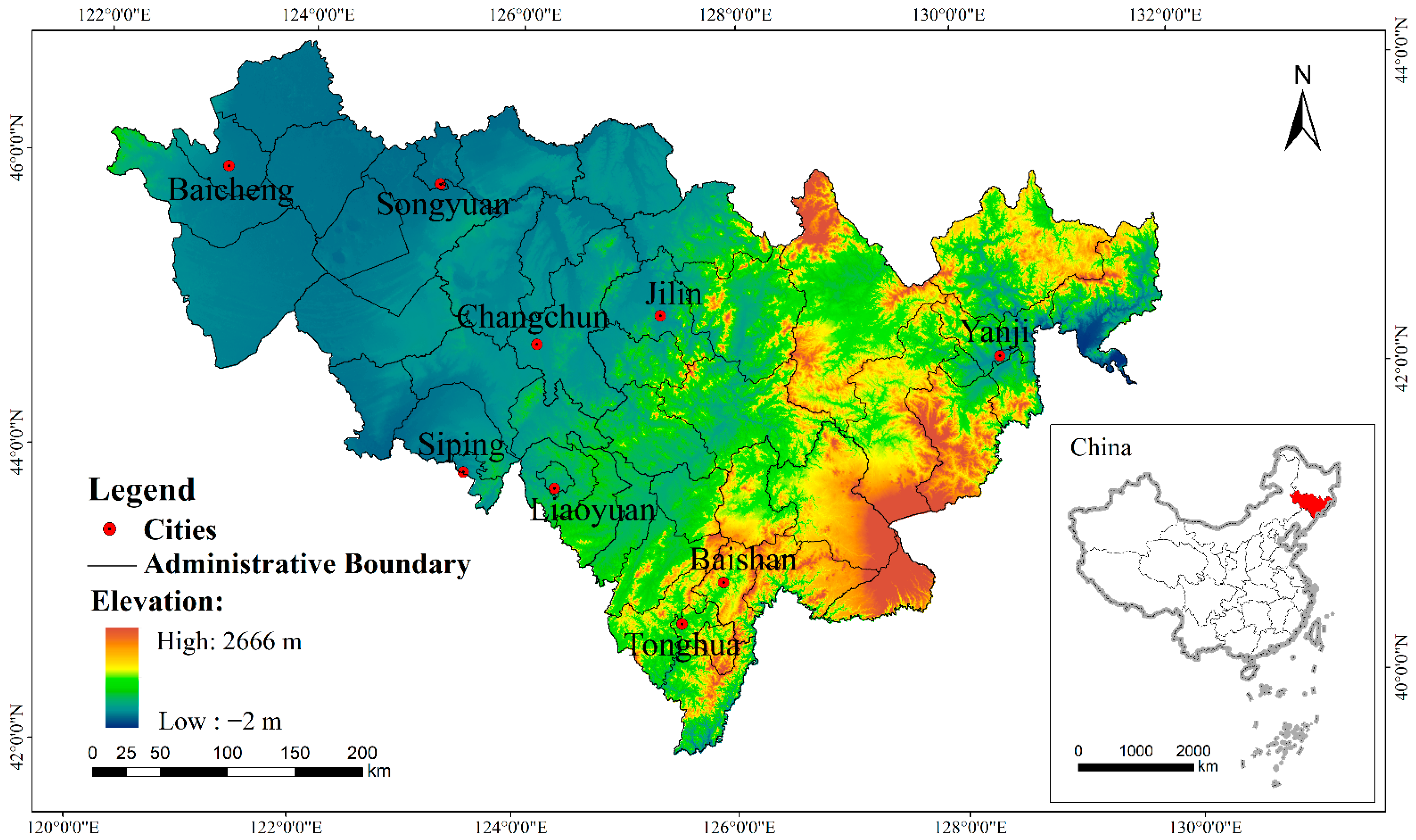
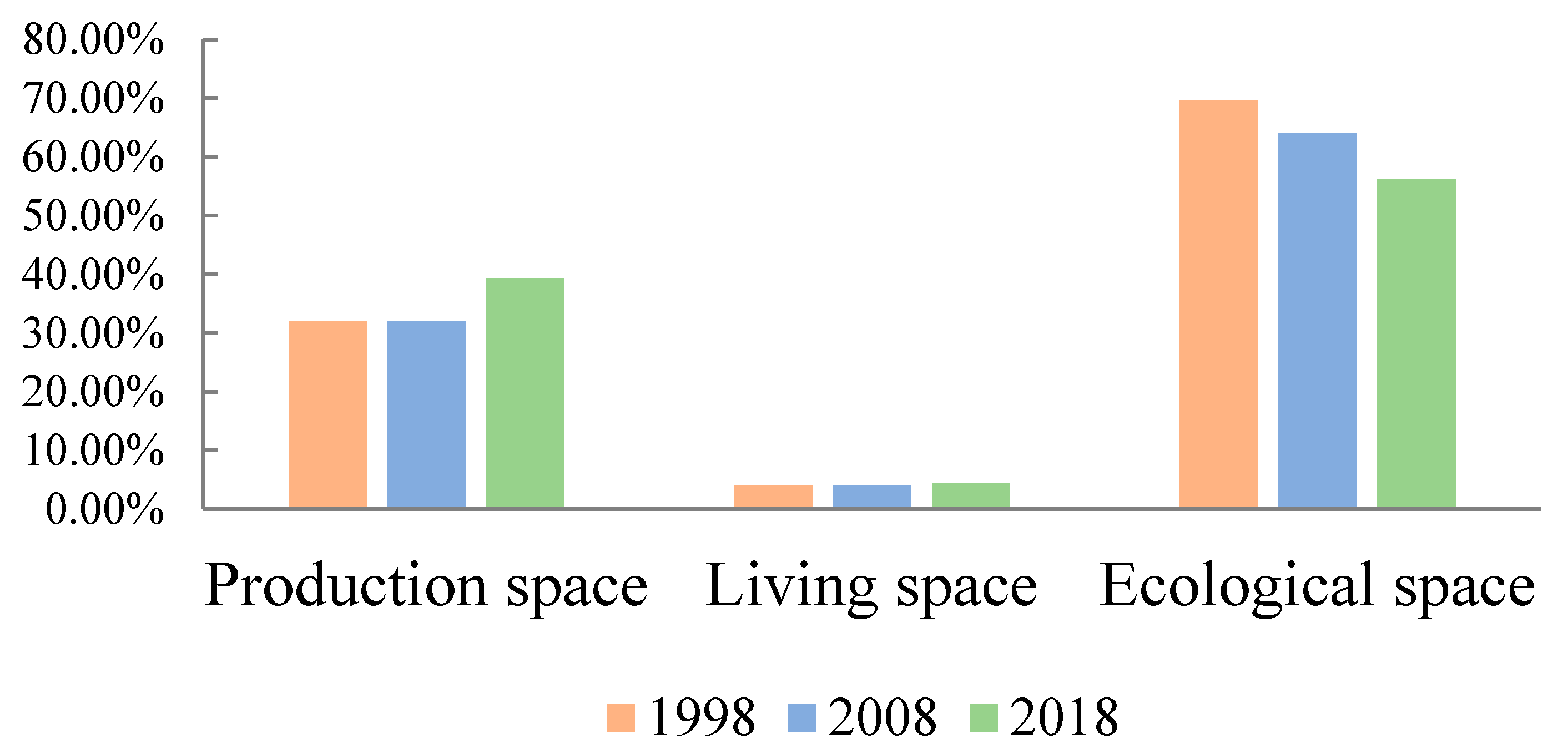
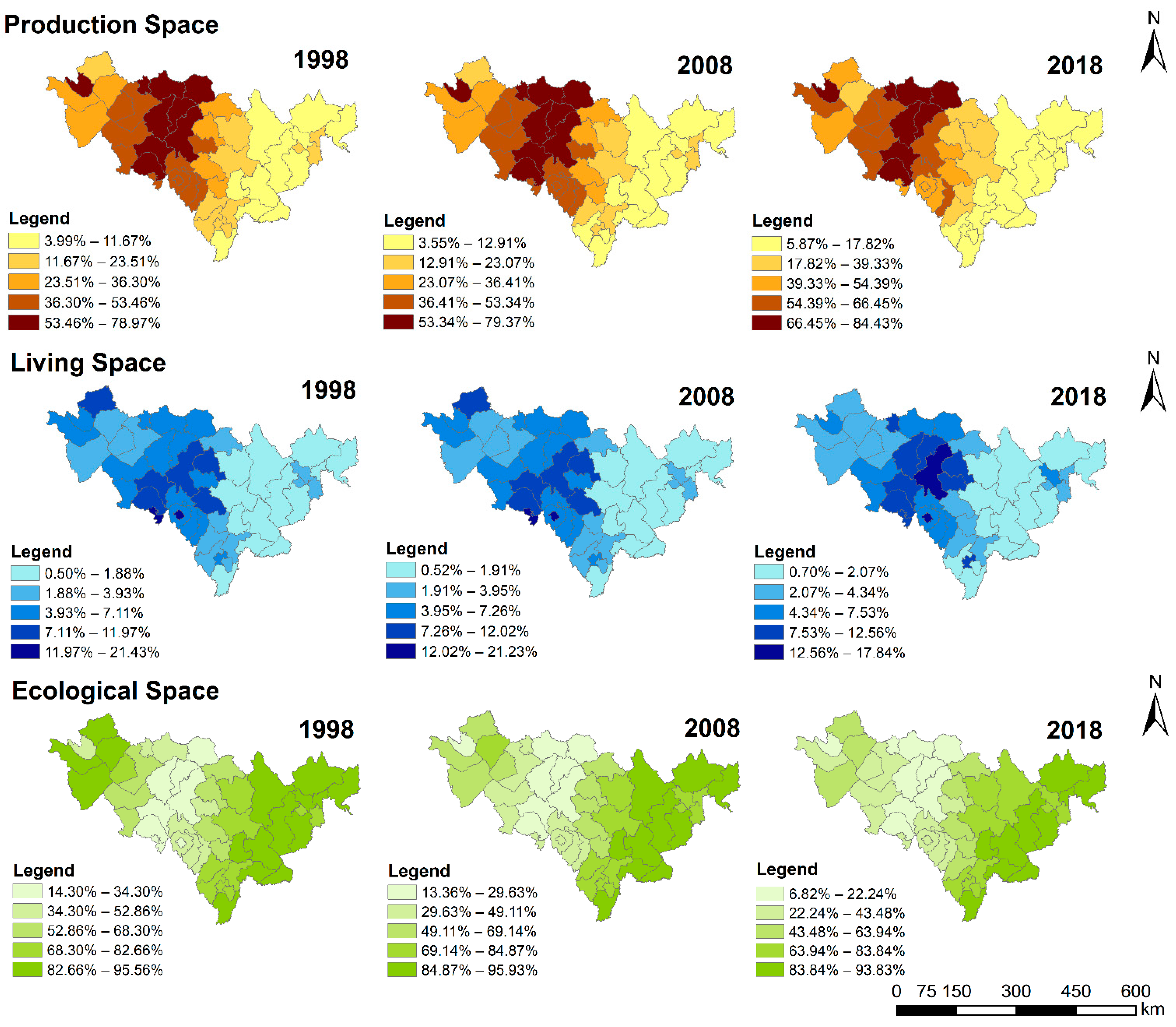
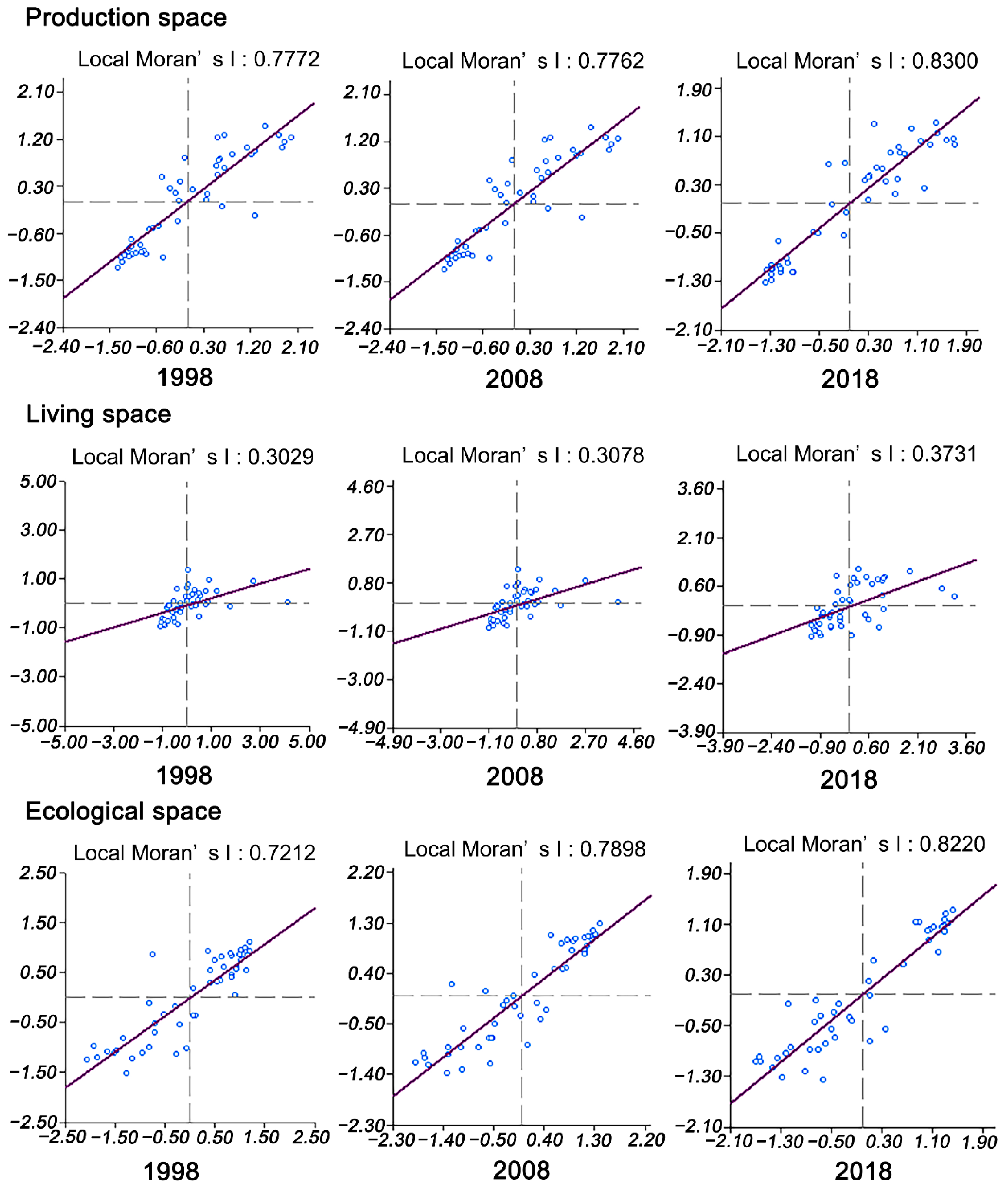
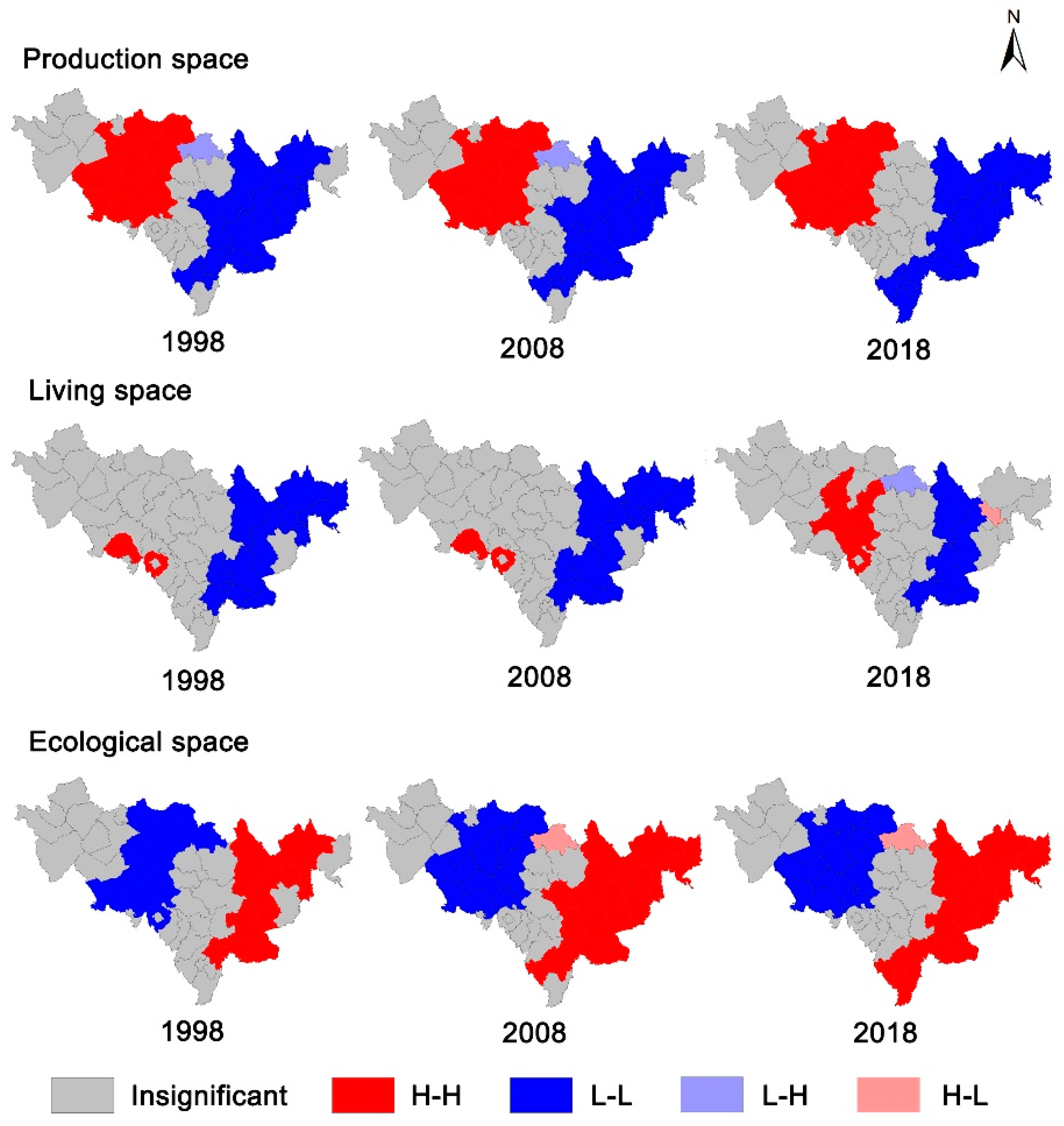
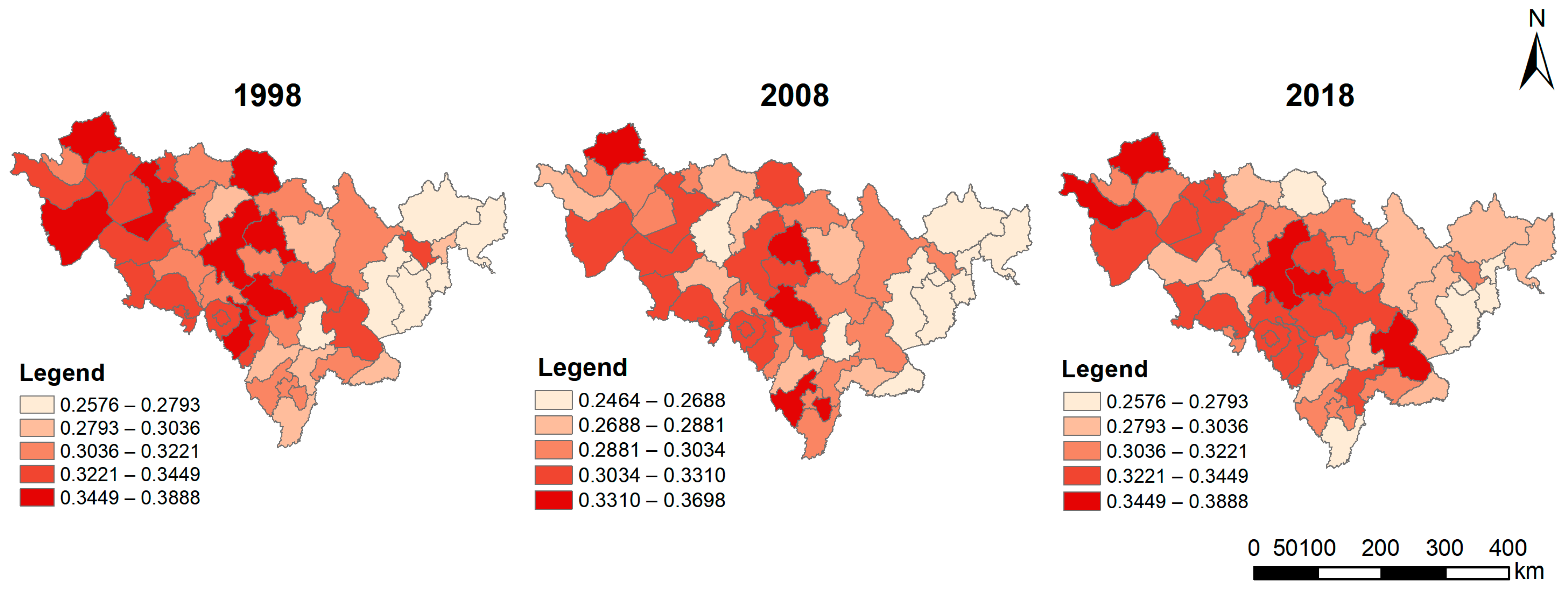
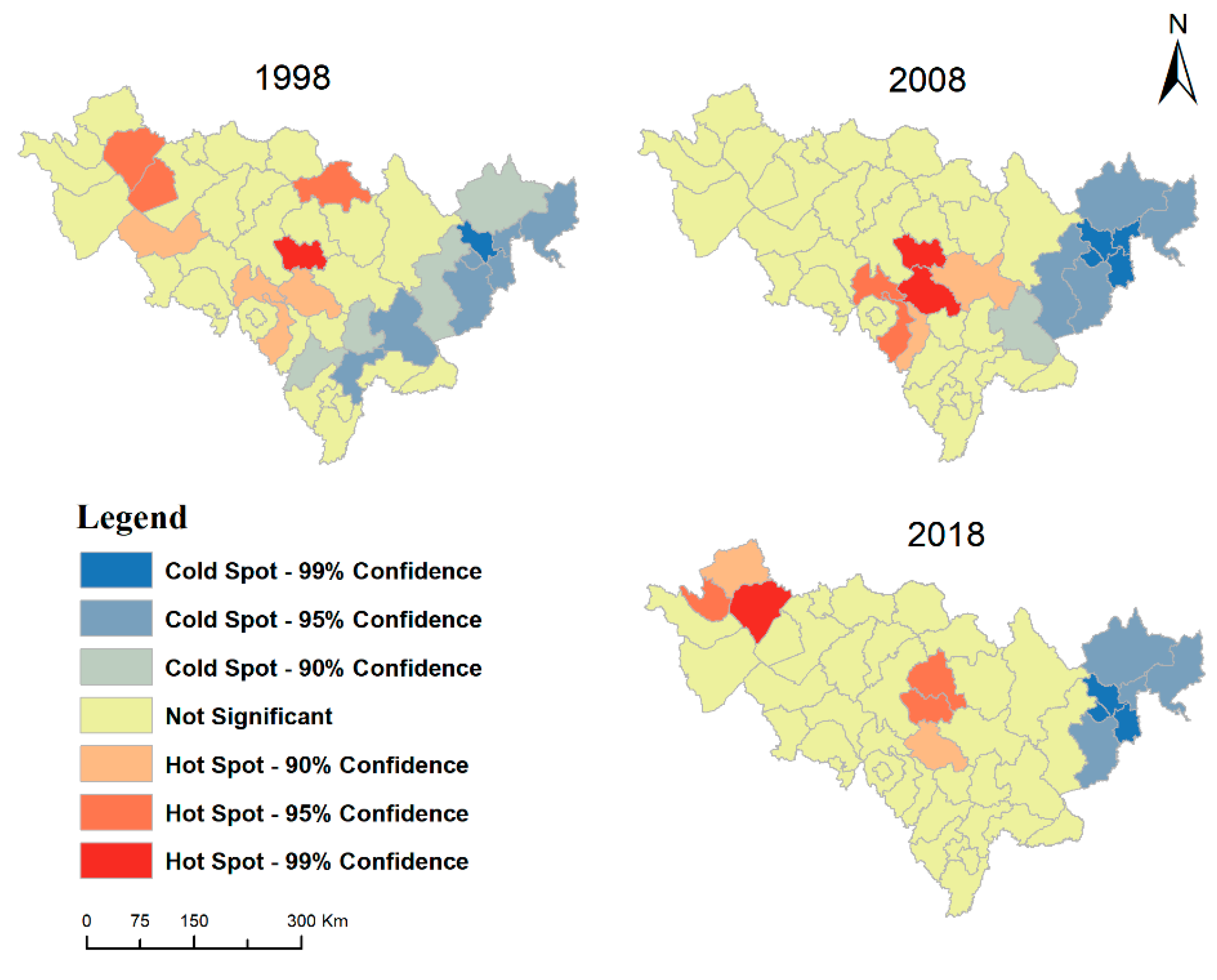
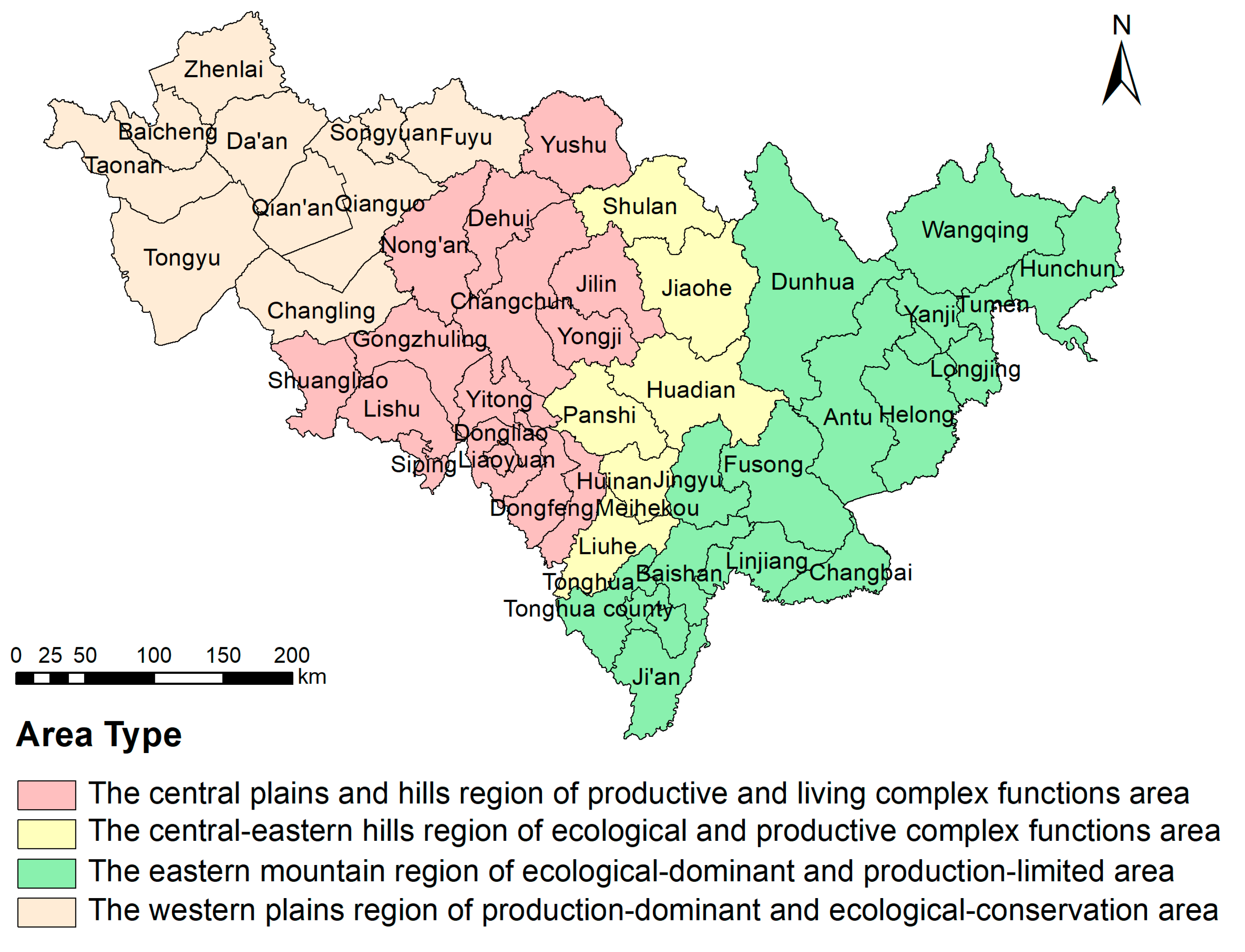
| First-Level Land-Use Type | Second-Level Land-Use Type | |||
|---|---|---|---|---|
| Code | Category Name | Code | Category Name | |
| Production space | 1 | Cultivated land | 011/012/013 | Paddy field/Irrigated land/The dry land |
| 2 | Garden land | 021/022/023 | The orchard/Tea garden/other garden | |
| 5 | Commercial service land | 051/052/053/054 | Wholesale retail land/Lodgings/Commercial and financial land/Other commercial service land | |
| 6 | Industrial and mining storage land | 061/062/063 | Industrial land/Mining land/Warehousing land | |
| 10 | Transportation land | 101/102/103/104/ | Railway land/Land for exlusive use by highways/Street land/Rural roads land/Airport land/Harbor land/Pipe land | |
| 105/106/107 | ||||
| 11 | Water area and water conservancy facilities land | 117/118 | The ditch/Water construction land | |
| 12 | Other lands | 122/123 | Facilities for agricultural land/Field ridge | |
| Living space | 7 | Residential land | 071/072 | Townhouse/House-site in the countryside |
| 8 | Public administration and public services land | 081/082/083/084/ | Land area/News site/Science and education land/Medical charity land/Recreational land/Utility land/Parks and green house/Land of scenic sites | |
| 085/086/087/088 | ||||
| 9 | Special land | 091/092/093/ | Military facilities/Embassies and consulates land/The site of the superintendent’s premises/Religious land/Land for the funeral | |
| 094/095 | ||||
| 12 | Other lands | 121 | Free land | |
| Ecological space | 3 | Woodland | 031/032/033 | Forestland/Shrub land/Other woodland |
| 4 | Grassland | 041/042/043 | Natural grassland/Artificial grassland/Other grass | |
| 11 | Water area and water conservancy facilities land | 111/112/113/114/ | The river water/The lake water/The reservoir water/Pits or surface/Coastal tidal flats/Inland tidal flats/Glaciers and permanent snow | |
| 115/116/119 | ||||
| 12 | Other lands | 124/125/126/127 | Saline-alkali land/Marsh/The sand/Bare land | |
| Subsystem | Evaluation Indicator (Unit) | Direction | Weight | |
|---|---|---|---|---|
| Production function | Per capita GDP (yuan/person) | P1 | + | 0.0822 |
| Per capita cultivated land area (m2/person) | P2 | + | 0.0773 | |
| Per capita output value of agriculture, forestry, animal husbandry and fishery (yuan/person) | P3 | + | 0.0732 | |
| (0.3500) | Gross output value of the second industry (ten thousand yuan) | P4 | + | 0.0261 |
| Gross output value of the third industry (ten thousand yuan) | P5 | + | 0.0276 | |
| The proportion of production space (%) | P6 | + | 0.0636 | |
| Living function | Density of population (person/hectare) | L1 | + | 0.0394 |
| Per capita construction land area (m2/person) | L2 | + | 0.0733 | |
| Density of traffic land (%) | L3 | + | 0.0691 | |
| (0.3803) | Number of students in primary and secondary schools (person) | L4 | + | 0.0541 |
| Number of hospital beds per 10,000 persons (beds per 10,000 persons) | L5 | + | 0.0753 | |
| The proportion of living space (%) | L6 | + | 0.0691 | |
| Ecological function | Forest coverage rate (%) | E1 | + | 0.0536 |
| Water coverage rate (%) | E2 | + | 0.0603 | |
| The proportion of the bare surface area (%) | E3 | + | 0.0578 | |
| Fertilizer application quantity (ton) | E4 | − | 0.0405 | |
| (0.2697) | The proportion of ecological space (%) | E5 | + | 0.0574 |
| Level | Classes | D Value |
|---|---|---|
| Low-degree coupling coordination | Extremely uncoordinated | [0, 0.1) |
| Severely uncoordinated | [0.1, 0.2) | |
| Moderately uncoordinated | [0.2, 0.3) | |
| Moderate coupling coordination | Slightly uncoordinated | [0.3, 0.4) |
| On the verge of uncoordinated | [0.4, 0.5) | |
| Barely coordinated | [0.5, 0.6) | |
| Highly coupling coordination | Primarily coordinated | [0.6, 0.7) |
| Intermediately coordinated | [0.7, 0.8) | |
| High quality coupling coordination | Well coordinated | [0.8, 0.9) |
| Superiorly coordinated | [0.9, 1] |
| Name | PS | LS | ES | Name | PS | LS | ES |
|---|---|---|---|---|---|---|---|
| Changchun urban area | 0.00% | 3.37% | −1.15% | Baishan urban area | −1.29% | 2.62% | 0.17% |
| Nong’an County | 0.22% | 1.27% | −2.05% | Fusong County | 1.51% | 3.31% | −0.12% |
| Yushu City | 0.54% | 1.25% | −2.92% | Jingyu County | 0.60% | 1.61% | −0.08% |
| Dehui City | 0.32% | 1.44% | −2.61% | Changbai County | 2.35% | 1.90% | −0.09% |
| Jilin urban area | 0.51% | −1.16% | −0.09% | Linjiang City | 2.18% | 0.79% | −0.13% |
| Yongji County | 0.76% | 2.77% | −0.89% | Songyuan urban area | 0.91% | 2.41% | −2.92% |
| Jiaohe City | 1.74% | 0.49% | −0.43% | Qianguo County | 1.07% | 0.76% | −2.26% |
| Huadian City | 2.86% | 0.92% | −0.59% | Changling County | 1.43% | 0.35% | −2.46% |
| Shulan City | 0.93% | 0.75% | −0.53% | Qian’an County | 1.62% | 1.50% | −2.28% |
| Panshi City | 2.60% | −2.71% | −0.97% | Fuyu City | 0.67% | 0.17% | −2.48% |
| Siping urban area | 0.11% | −1.02% | 0.31% | Baicheng urban area | 0.65% | 0.65% | −2.79% |
| Lishu County | 0.88% | 0.43% | −2.12% | Taonan City | 3.33% | −1.39% | −2.95% |
| Yitong County | 0.95% | 0.95% | −1.34% | Zhenlai County | 5.59% | −2.77% | −2.21% |
| Gongzhuling City | 0.40% | 0.96% | −2.52% | Tongyu County | 3.54% | −1.30% | −2.41% |
| Shuangliao City | 2.08% | 0.00% | −2.60% | Da’an City | 1.15% | 0.95% | −1.29% |
| Liaoyuan urban area | 0.32% | −0.84% | 0.10% | Yanji City | 2.24% | 3.14% | −0.47% |
| Dongfeng County | 0.76% | 0.65% | −0.81% | Tumen City | −0.55% | 3.36% | −0.05% |
| Dongliao County | 0.22% | 1.26% | −0.38% | Dunhua City | 2.60% | 1.16% | −0.42% |
| Tonghua urban area | −0.88% | 1.34% | 0.06% | Hunchun City | 1.16% | 1.85% | −0.28% |
| Tonghua County | 0.44% | −2.37% | 0.04% | Longjing City | −1.21% | 0.28% | 0.31% |
| Huinan County | 1.55% | 1.32% | −0.79% | Helong City | −0.03% | 0.55% | −0.01% |
| Liuhe County | 3.84% | 0.92% | −1.14% | Wangqing County | 0.29% | −0.34% | −0.08% |
| Meihekou City | 1.10% | 1.06% | −1.31% | Antu County | 1.56% | 1.11% | −0.13% |
| Ji’an City | −0.80% | −0.98% | 0.10% |
| Space Type | Year | Moran’s I | Z | P |
|---|---|---|---|---|
| Production space | 1998 | 0.7925 | 8.6830 | 0.0000 |
| 2008 | 0.7925 | 8.6852 | 0.0000 | |
| 2018 | 0.8212 | 8.9600 | 0.0000 | |
| Living space | 1998 | 0.2710 | 3.3600 | 0.0008 |
| 2008 | 0.2820 | 3.4612 | 0.0005 | |
| 2018 | 0.3571 | 4.1719 | 0.0000 | |
| Ecological space | 1998 | 0.7073 | 7.7790 | 0.0000 |
| 2008 | 0.7809 | 8.5478 | 0.0000 | |
| 2018 | 0.8096 | 8.8358 | 0.0000 |
| Name | Pi | Li | Ei | ||||||
|---|---|---|---|---|---|---|---|---|---|
| 1998 | 2008 | 2018 | 1998 | 2008 | 2018 | 1998 | 2008 | 2018 | |
| Changchun urban area | 0.2134 | 0.2019 | 0.1956 | 0.1844 | 0.1973 | 0.2584 | 0.0439 | 0.0301 | 0.0465 |
| Nong’an County | 0.2097 | 0.1678 | 0.1773 | 0.1197 | 0.1245 | 0.1596 | 0.0321 | 0.0158 | 0.0291 |
| Yushu City | 0.1731 | 0.1464 | 0.1553 | 0.0977 | 0.0969 | 0.1212 | 0.0867 | 0.0718 | 0.0166 |
| Dehui City | 0.1894 | 0.1849 | 0.1923 | 0.1076 | 0.1121 | 0.1461 | 0.0310 | 0.0249 | 0.0379 |
| Jilin urban area | 0.1073 | 0.0990 | 0.0870 | 0.1793 | 0.1641 | 0.1600 | 0.1340 | 0.0985 | 0.1204 |
| Yongji County | 0.1166 | 0.1279 | 0.1043 | 0.0806 | 0.0897 | 0.1499 | 0.0976 | 0.0971 | 0.1298 |
| Jiaohe City | 0.1028 | 0.1042 | 0.0989 | 0.0456 | 0.0430 | 0.0721 | 0.1379 | 0.1248 | 0.1313 |
| Huadian City | 0.1331 | 0.1224 | 0.1206 | 0.0568 | 0.0497 | 0.0631 | 0.1403 | 0.1281 | 0.1544 |
| Shulan City | 0.1188 | 0.0976 | 0.1062 | 0.0692 | 0.0700 | 0.0785 | 0.1072 | 0.0984 | 0.1339 |
| Panshi City | 0.1198 | 0.1625 | 0.1265 | 0.1524 | 0.1581 | 0.0847 | 0.1160 | 0.0995 | 0.1073 |
| Tonghua urban area | 0.0561 | 0.0404 | 0.0403 | 0.1147 | 0.1087 | 0.1489 | 0.1353 | 0.1391 | 0.1500 |
| Tonghua County | 0.0851 | 0.1054 | 0.0745 | 0.0647 | 0.0766 | 0.0806 | 0.1470 | 0.2052 | 0.1509 |
| Huinan County | 0.0803 | 0.0997 | 0.0922 | 0.0635 | 0.0587 | 0.0856 | 0.1408 | 0.1877 | 0.1237 |
| Liuhe County | 0.0917 | 0.0518 | 0.0878 | 0.0472 | 0.0520 | 0.0784 | 0.1301 | 0.1819 | 0.1055 |
| Ji’an City | 0.0682 | 0.0859 | 0.0503 | 0.0453 | 0.0435 | 0.0502 | 0.1684 | 0.1597 | 0.1650 |
| Meihekou City | 0.1349 | 0.0890 | 0.1317 | 0.0884 | 0.0876 | 0.1145 | 0.0970 | 0.0835 | 0.0787 |
| Siping urban area | 0.0770 | 0.0783 | 0.0629 | 0.1968 | 0.2086 | 0.1992 | 0.0862 | 0.0796 | 0.0890 |
| Lishu County | 0.1721 | 0.1714 | 0.1729 | 0.1108 | 0.0988 | 0.1692 | 0.0524 | 0.0504 | 0.0412 |
| Yitong County | 0.1399 | 0.1352 | 0.1385 | 0.0482 | 0.0525 | 0.0987 | 0.1111 | 0.0969 | 0.0866 |
| Shuangliao City | 0.1564 | 0.1541 | 0.1526 | 0.1010 | 0.0905 | 0.1426 | 0.0837 | 0.0695 | 0.0587 |
| Gongzhuling City | 0.1954 | 0.1620 | 0.1562 | 0.1208 | 0.1106 | 0.1860 | 0.0335 | 0.0271 | 0.0270 |
| Baishan urban area | 0.0766 | 0.0618 | 0.0735 | 0.0542 | 0.0694 | 0.1030 | 0.1513 | 0.1476 | 0.1619 |
| Fusong County | 0.0681 | 0.0646 | 0.0934 | 0.0893 | 0.0705 | 0.1061 | 0.1598 | 0.1597 | 0.2095 |
| Jingyu County | 0.0530 | 0.0644 | 0.0831 | 0.0307 | 0.0390 | 0.0551 | 0.1536 | 0.1505 | 0.1543 |
| Changbai County | 0.1018 | 0.0546 | 0.0876 | 0.0366 | 0.0343 | 0.0421 | 0.1638 | 0.1610 | 0.1709 |
| Linjiang City | 0.0859 | 0.0587 | 0.0832 | 0.0540 | 0.0550 | 0.0655 | 0.1614 | 0.1593 | 0.1589 |
| Liaoyuan urban area | 0.0653 | 0.0652 | 0.0815 | 0.1961 | 0.2095 | 0.2081 | 0.0744 | 0.0728 | 0.0819 |
| Dongfeng County | 0.1283 | 0.1163 | 0.1291 | 0.1091 | 0.1019 | 0.1016 | 0.1151 | 0.1110 | 0.0899 |
| Dongliao County | 0.1182 | 0.1206 | 0.1158 | 0.0992 | 0.0945 | 0.1071 | 0.0978 | 0.0844 | 0.0994 |
| Baicheng urban area | 0.1066 | 0.1111 | 0.1204 | 0.1120 | 0.1237 | 0.1443 | 0.0656 | 0.0478 | 0.0595 |
| Taonan City | 0.1142 | 0.1045 | 0.1493 | 0.0927 | 0.0739 | 0.1460 | 0.1099 | 0.0740 | 0.1033 |
| Da’an City | 0.0910 | 0.0856 | 0.0992 | 0.0852 | 0.0789 | 0.1040 | 0.1412 | 0.0966 | 0.1066 |
| Zhenlai County | 0.0820 | 0.1259 | 0.2005 | 0.1338 | 0.1246 | 0.1340 | 0.1535 | 0.0974 | 0.1285 |
| Tongyu County | 0.1425 | 0.1165 | 0.1641 | 0.0979 | 0.0894 | 0.1133 | 0.1122 | 0.0837 | 0.0715 |
| Songyuan urban area | 0.1071 | 0.1216 | 0.1176 | 0.0921 | 0.0782 | 0.1496 | 0.1040 | 0.0768 | 0.0837 |
| Changling County | 0.1497 | 0.1557 | 0.1612 | 0.1021 | 0.0921 | 0.1162 | 0.0801 | 0.0644 | 0.0346 |
| Qian’an County | 0.1544 | 0.1549 | 0.1747 | 0.0679 | 0.0659 | 0.1039 | 0.1000 | 0.0710 | 0.0927 |
| Qianguo County | 0.2086 | 0.2326 | 0.1820 | 0.0749 | 0.0709 | 0.1046 | 0.1281 | 0.0674 | 0.0784 |
| Fuyu City | 0.1730 | 0.1553 | 0.1669 | 0.0805 | 0.0764 | 0.0953 | 0.0546 | 0.0369 | 0.0444 |
| Yanji City | 0.0698 | 0.0575 | 0.0607 | 0.1038 | 0.0954 | 0.1156 | 0.1418 | 0.1395 | 0.1416 |
| Tumen City | 0.0592 | 0.0336 | 0.0239 | 0.0689 | 0.0561 | 0.0795 | 0.1416 | 0.1362 | 0.1543 |
| Dunhua City | 0.0897 | 0.0740 | 0.0726 | 0.0584 | 0.0569 | 0.0699 | 0.1579 | 0.1516 | 0.1386 |
| Hunchun City | 0.0522 | 0.0569 | 0.0543 | 0.0516 | 0.0316 | 0.0756 | 0.1727 | 0.1843 | 0.1657 |
| Longjing City | 0.0641 | 0.0530 | 0.0439 | 0.0564 | 0.0487 | 0.0762 | 0.1268 | 0.1263 | 0.1422 |
| Helong City | 0.0450 | 0.0469 | 0.0331 | 0.0633 | 0.0321 | 0.0642 | 0.1497 | 0.1492 | 0.1521 |
| Wangqing County | 0.0598 | 0.0631 | 0.0663 | 0.0425 | 0.0374 | 0.0574 | 0.1480 | 0.1464 | 0.1478 |
| Antu County | 0.0783 | 0.0577 | 0.0537 | 0.0379 | 0.0391 | 0.0652 | 0.1523 | 0.1501 | 0.1550 |
| Name | D(1998) | D(2008) | D(2018) | Name | D(1998) | D(2008) | D(2018) |
|---|---|---|---|---|---|---|---|
| Changchun urban area | 0.3464 | 0.3260 | 0.3647 | Changbai County | 0.2913 | 0.2589 | 0.2928 |
| Nong’an County | 0.3050 | 0.2629 | 0.3062 | Linjiang City | 0.3013 | 0.2830 | 0.3087 |
| Yushu City | 0.3370 | 0.3171 | 0.2604 | Liaoyuan urban area | 0.3137 | 0.3159 | 0.3340 |
| Dehui City | 0.2929 | 0.2833 | 0.3195 | Dongfeng County | 0.3424 | 0.3310 | 0.3250 |
| Jilin urban area | 0.3703 | 0.3420 | 0.3446 | Dongliao County | 0.3235 | 0.3142 | 0.3275 |
| Yongji County | 0.3117 | 0.3220 | 0.3558 | Baicheng urban area | 0.3036 | 0.2949 | 0.3180 |
| Jiaohe City | 0.2941 | 0.2871 | 0.3128 | Taonan City | 0.3243 | 0.2881 | 0.3620 |
| Huadian City | 0.3193 | 0.3034 | 0.3249 | Da’an City | 0.3210 | 0.2945 | 0.3213 |
| Shulan City | 0.3097 | 0.2960 | 0.3221 | Zhenlai County | 0.3449 | 0.3394 | 0.3888 |
| Panshi City | 0.3583 | 0.3698 | 0.3237 | Tongyu County | 0.3407 | 0.3091 | 0.3316 |
| Tonghua urban area | 0.3090 | 0.2913 | 0.3107 | Songyuan urban area | 0.3176 | 0.3001 | 0.3373 |
| Tonghua County | 0.3053 | 0.3440 | 0.3111 | Changling County | 0.3270 | 0.3121 | 0.2942 |
| Huinan County | 0.2993 | 0.3212 | 0.3149 | Qian’an County | 0.3187 | 0.2997 | 0.3449 |
| Liuhe County | 0.2873 | 0.2808 | 0.2998 | Qianguo County | 0.3550 | 0.3219 | 0.3381 |
| Ji’an City | 0.2836 | 0.2902 | 0.2733 | Fuyu City | 0.3021 | 0.2755 | 0.2984 |
| Meihekou City | 0.3240 | 0.2944 | 0.3254 | Yanji City | 0.3176 | 0.3024 | 0.3159 |
| Siping urban area | 0.3306 | 0.3304 | 0.3221 | Tumen City | 0.2886 | 0.2521 | 0.2577 |
| Lishu County | 0.3162 | 0.3080 | 0.3262 | Dunhua City | 0.3064 | 0.2934 | 0.2982 |
| Yitong County | 0.3013 | 0.2971 | 0.3252 | Hunchun City | 0.2784 | 0.2631 | 0.2966 |
| Shuangliao City | 0.3312 | 0.3146 | 0.3294 | Longjing City | 0.2776 | 0.2623 | 0.2793 |
| Gongzhuling City | 0.3041 | 0.2803 | 0.3036 | Helong City | 0.2743 | 0.2465 | 0.2619 |
| Baishan urban area | 0.2927 | 0.2930 | 0.3272 | Wangqing County | 0.2687 | 0.2649 | 0.2873 |
| Fusong County | 0.3147 | 0.2999 | 0.3572 | Antu County | 0.2771 | 0.2640 | 0.2856 |
| Jingyu County | 0.2510 | 0.2689 | 0.2984 | Average value | 0.3109 | 0.2981 | 0.3163 |
| Type | Classes | Interval Value | Proportion in 1998 | Proportion in 2008 | Proportion in 2018 |
|---|---|---|---|---|---|
| Production-living-ecological | Moderately uncoordinated | [0.2–0.3) | 29.79% | 57.45% | 29.79% |
| Slightly uncoordinated | [0.3–0.4) | 70.21% | 42.55% | 70.21% | |
| Production-living | Severely uncoordinated | [0.1–0.2) | 0.00% | 2.13% | 0.00% |
| Moderately uncoordinated | [0.2–0.3) | 46.81% | 51.06% | 40.43% | |
| Slightly uncoordinated | [0.3–0.4) | 51.06% | 42.55% | 46.81% | |
| On the verge of uncoordinated | [0.4–0.5) | 2.13% | 4.26% | 12.77% | |
| Production-ecological | Moderately uncoordinated | [0.2–0.3) | 17.02% | 31.91% | 29.79% |
| Slightly uncoordinated | [0.3–0.4) | 80.85% | 68.09% | 68.09% | |
| On the verge of uncoordinated | [0.4–0.5) | 2.13% | 0.00% | 2.13% | |
| Living-ecological | Moderately uncoordinated | [0.2–0.3) | 40.43% | 65.96% | 80.85% |
| Slightly uncoordinated | [0.3–0.4) | 59.57% | 34.04% | 19.15% |
Publisher’s Note: MDPI stays neutral with regard to jurisdictional claims in published maps and institutional affiliations. |
© 2021 by the authors. Licensee MDPI, Basel, Switzerland. This article is an open access article distributed under the terms and conditions of the Creative Commons Attribution (CC BY) license (https://creativecommons.org/licenses/by/4.0/).
Share and Cite
Wei, L.; Zhang, Y.; Wang, L.; Mi, X.; Wu, X.; Cheng, Z. Spatiotemporal Evolution Patterns of “Production-Living-Ecological” Spaces and the Coordination Level and Optimization of the Functions in Jilin Province. Sustainability 2021, 13, 13192. https://doi.org/10.3390/su132313192
Wei L, Zhang Y, Wang L, Mi X, Wu X, Cheng Z. Spatiotemporal Evolution Patterns of “Production-Living-Ecological” Spaces and the Coordination Level and Optimization of the Functions in Jilin Province. Sustainability. 2021; 13(23):13192. https://doi.org/10.3390/su132313192
Chicago/Turabian StyleWei, Lanyi, Yanjun Zhang, Lingzhi Wang, Xiaoyuan Mi, Xuying Wu, and Zilang Cheng. 2021. "Spatiotemporal Evolution Patterns of “Production-Living-Ecological” Spaces and the Coordination Level and Optimization of the Functions in Jilin Province" Sustainability 13, no. 23: 13192. https://doi.org/10.3390/su132313192
APA StyleWei, L., Zhang, Y., Wang, L., Mi, X., Wu, X., & Cheng, Z. (2021). Spatiotemporal Evolution Patterns of “Production-Living-Ecological” Spaces and the Coordination Level and Optimization of the Functions in Jilin Province. Sustainability, 13(23), 13192. https://doi.org/10.3390/su132313192





